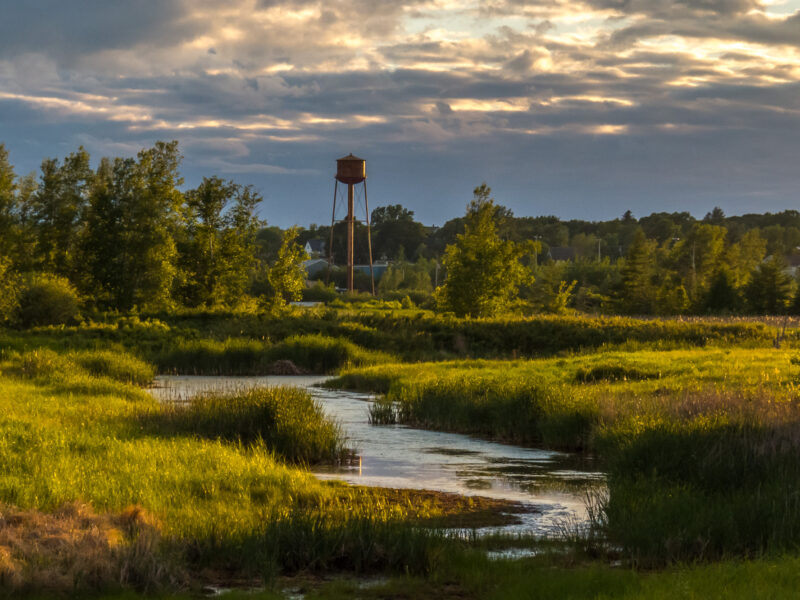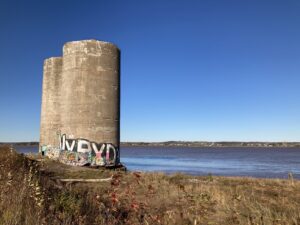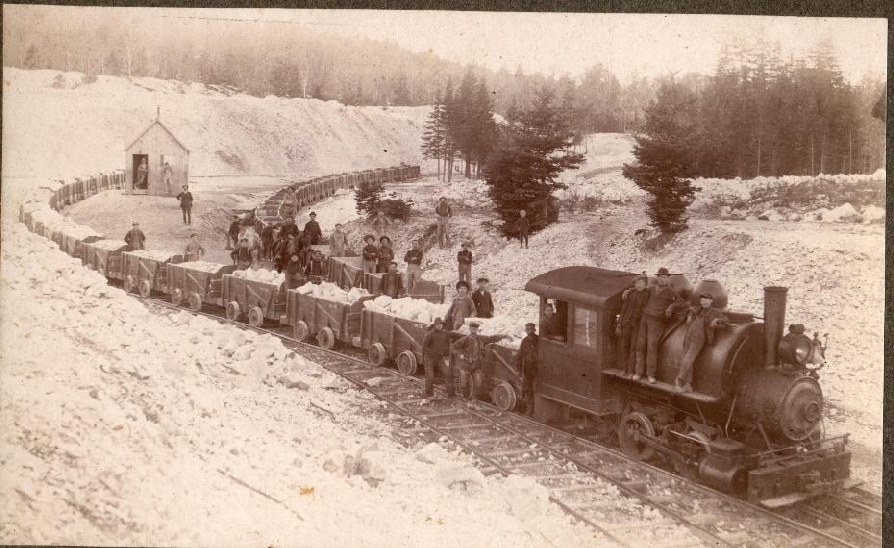
Resource to Recreation
(Excerpt from Saltscapes Magazine Aug/Sept 2024)
How a New Brunswick village turned an industrial wasteland into a sylvan refuge
The breeze off the water has an edge to it and I pause beside a stand of common reed along the marsh trail leading to the Petitcodiac River. They whiffle back and forth and I listen to their soothing music for a moment before climbing the riverside dyke towards two towering silos, leftovers from a gypsum industry that closed in the 1980s. The marsh wasn’t so quiet back then.
From this vantage, I look back towards the village of Hillsborough, N.B., tucked into the lee of the hills that inspired its name. A variety of landscapes stretch before me: patches of young forest, hay pastures and wildflower meadows, seas of greening cattails bordering a trio of shallow ponds. Habitat for geese and ducks, warblers and hawks, muskrats and beaver, coyote and fox — a diversity of wildlife that changes with the seasons. One spring, I walked here with a birder and he spotted 52 different species in an hour.

Gypsum silos (photo copyright Deborah Carr)
All the marsh trails lead towards these giant silos, connected like a pair of cement binoculars at the water’s edge. An anomaly in the surrounding landscape, they certainly draw attention. Industrial remnants reborn as curiosity; a canvas for youthful graffiti that also changes as the seasons pass.
Workers built the silos in 1926 to store gypsum awaiting shipment to ports worldwide. They remain a resilient landmark on the river’s edge, anchored on wooden pilings sunk in mud, the rest of the accompanying wharf long gone. Time, tide, and blustery storm surges undermine them, eroding the mud, worrying away chunks of cement. Someday, these forces will prove too much. But for now, the silos resist.
In this era of rapid change, we need reminders of resilience and resistance.
Smuggler heaven and the white kingdom
Geological time was kind to this region. What was once an ancient sea evaporated, leaving behind white gypsum cliffs of exceptional purity. In her book, Gesner’s Dream: The Trials and Triumphs of Early Mining in New Brunswick (2003), the late Gwen Martin wrote that settler families in the 1700s quarried gypsum on their own properties to use as a soil conditioner and sold the excess to the captains of schooners plying the Petitcodiac River. I spoke to her about her research a few months before she passed away.

Late New Brunswick author and geologist Gwen L Martin documented the region’s mining history in her book, Gesner’s Dream. (photo copyright Deborah Carr)
“The captains sailed down the Bay of Fundy to the Fundy Isles,” she said, “keeping just this side of the international boundary. American ships waited for them, hiding among the various islands. The sailors then traded the gypsum for American liquor, tea and other goodies. It was smuggler heaven. And what you might call the earliest cross-border shopping.”
Samuel and Charles Fowler were the first to officially ship gypsum direct from Hillsborough to their mill in Lubec, Maine. Then in 1854, New York businessman Calvin Tompkins came north to start the Albert Manufacturing Company (AMC). Initially, to avoid import fees, he quarried and shipped raw rock to New England for manufacture, but after tariffs lessened, he opened a mill on this marshland to process the gypsum into plaster.
The mill burned in 1872, but Tompkins rebuilt. The new site had a steam plant, calcining house, plaster storehouse, plaster mill, cooper shop, hoop storehouse, engine house, boiler room, and sawmill.
According to Martin, AMC was once the largest gypsum manufacturing plant in North America, winning awards and employing up to 325 men. Some called it the “white kingdom.” Multiple quarries fed the plant as mountains of the famous Hammer Brand Hard Wall Plaster, stacks of wallboard, and material for denture molds shipped across the planet. At one point, large alabaster-like blocks journeyed to New York and Pennsylvania, destined to become sculptures, pedestals, and clocks.

Small steam engines, nicknamed Tad and Connie, hauled gypsum several kilometres from the quarries to the manufacturing plant. (photo courtesy Albert County Museum)
After miners exhausted surface deposits, they cut tunnels into the bedrock and worked with acetylene lighting. They drilled, pounded, and hacked subterranean rock into piles that they loaded into rail cars and hauled to the surface with horses. By the turn of the century, two tiny steam locomotives replaced the horses. The Tad and Connie towed long strings of open cars filled with rock to the mill, four times daily.
Occasionally, the trains also ferried bedecked and parasoled party-goers to company garden parties; other times they were hijacked for more clandestine expeditions.
“In the early 1900s, younger residents had another form of entertainment,” Martin told me. “On Sundays, they’d sneak uphill to a quarry, loosen the brakes of an empty ore car, and ride it hell for leather down the tracks to town.”
Another fire levelled the plant in 1911. The company rebuilt and was back in operation within a year, however, the cascading impacts of the First World War, increasing export tariffs, and the stock market crash of 1929, triggered a downturn. A year later, AMC sold its assets to the Canadian Gypsum Company Limited, which continued production until 1982.
White rock kept the village thriving for almost two centuries, feeding both local families and the bank accounts of its wealthy owners. It gave, but it also took away.
“Many were the injuries or deaths from collapsing roof rock,” said Martin. “Believe it or not, New Brunswick didn’t even have mine safety legislation until 1933.”
My own family members tell me stories of coming home from work with hair and clothing plastered in fine, white dust, and of fellow workers dying of lung disease.
When the company ceased operation, the quarries were abandoned, the plant dismembered, the site levelled, and remaining debris ploughed into the dyke system. Besides the silos, all that remained were a few repurposed buildings and a rusting water tower. The land starved and seeped; little grew on the barren ground. The village suffered, too, in the way of boom and bust, but harnessing a resilient spirit, it staggered on.
(Read the rest in Saltscapes Magazine, Aug/Sept 2024 issue; Cover photo: reclaimed marshland on former mill site, copyright Deborah Carr)




